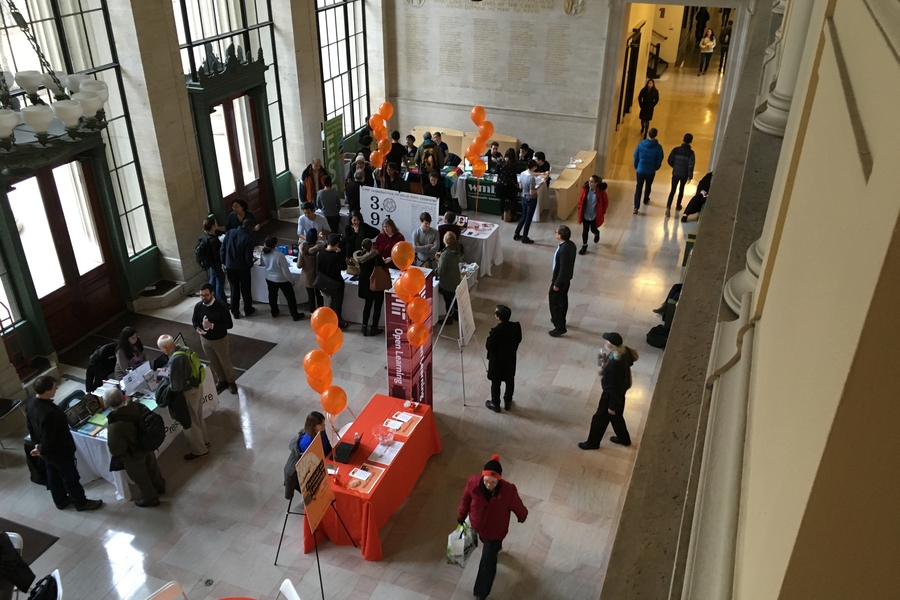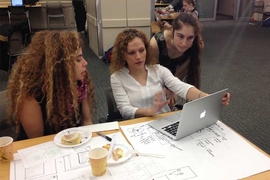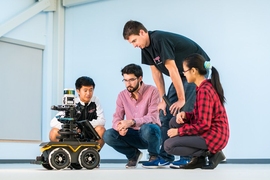Instead of flipping the classroom — viewing lectures in advance and using class time to solve problems — Carl Wieman ’73 flipped the audience at the second annual MIT Festival of Learning. To reach students, the kickoff speaker said he retooled his standard faculty talk about new approaches to teaching.
After all, they “often have more expertise on learning than most faculty do,” he said.
Wieman, a Nobel Prize-winning Stanford physicist, urged the hundreds of students in the audience to take control of their own education at the Jan. 29 event. In other words, he added, “hold faculty and administrators more accountable” when teaching is not up to snuff.
Wieman knows of what he speaks. When he realized the students in one of his atomic physics classes were not mastering fundamental concepts, he investigated ways to improve his teaching — a journey he describes further in his book, “Improving How Universities Teach Science.” Decades of research in cognitive and learning sciences, he discovered, revealed that having students take notes based upon lectures (what Wieman calls “filling the brain”) is one of the least effective ways to learn. So, he abandoned traditional classroom lecturing.
Instead, active learning, or group and problem-based teaching with a focus on timely feedback, works better. He has seen the positive results in his own classes, as well as via longitudinal studies he has co-authored. Wieman feels that the goal should be to teach students “how to be experts” by helping them understand what tools, resources, and knowledge to use when tackling real problems. After all, that’s what experts like him, and other faculty and researchers, do in their labs.
Asking students to solve typical exam problems without calculators, notes, or instruments, “as if they were shipwrecked on an island,” is both artificial and arbitrary. Moreover, Wieman added, “real knowledge does not come with chapter numbers,” so teaching to the test does not provide students with ways to cope with novel situations.
Like learning, teaching requires expertise. Too often, he said, faculty are not given the time, opportunity, or right incentives to develop their teaching skills. This leads to learning environments akin to medicine in the mid-19th century, when “anyone who simply did things to people” could be considered a doctor. Switching his tone at the end of this talk and eyeing the administrators in the room, Wieman said that universities need to move away from the “pedagogical equivalent of bloodletting” and take steps to put effective and evidence-based teaching front and center.
After his lecture (or “sermon,” as he called it), Wieman’s message was amplified by a series of lightning-round talks by MIT faculty who have embraced innovative teaching. Anette “Peko” Hosoi, associate dean of engineering and the Neil and Jane Pappalardo Professor of Mechanical Engineering, provided an update on the New Engineering Education Transformation (NEET) pilot initiative, centered around interdisciplinary projects to prepare students for the practice of engineering, specifically in emerging areas such as autonomy and living machines. Each speaker talked about the dual benefit of such experiments: enhancing the student experience as well as reinvigorating their own on-campus teaching in different ways by making their students’ learning much more active.
Inspired by the goody bags his 6-year-old daughter receives at friends’ birthday parties, Jeffery Grossman, the Morton and Claire Goulder and Family Professor in Environmental Systems, created hands-on experimental kits for 3.091 (Introduction to Solid State Chemistry). Filled with simple components, common agents like vinegar, and instructions, students were given an opportunity to explore even the most theoretical topics in tangible ways, from the makeup of metals to chemical structures. “I was thrilled when I saw a group of students dousing various metals in the Infinite Corridor with vinegar,” Grossman said. (For those who are curious, example bags are on display in the Infinite Corridor).
Three faculty, Shigeru Miyagawa, Thomas Kochan, and Barton Zwiebach, all zeroed in on ways they have used technology to go beyond the walls of the classroom. Miyagawa, a professor of linguistics and the Kochi-Manjiro Professor of Japanese Language and Culture, incorporates digital images from dozens of museums and collections and draws upon worldwide experts in Visualizing Japan, a flipped-format online and residential experience.
For an assignment to develop a new employment bill of rights that reflects the changing economy, Kochan, the George Maverick Bunker Professor of Management, uses social platforms to virtually mix MBA students with workers in the field, adding an eye-opening real-life dimension to their training. Finally, Zwiebach, a professor of physics, has retooled a sequence of courses in quantum physics (8.04, 8.05, and 8.06) via MITx to allow students more flexibility about how and when to take them.
Vice Chancellor Ian A. Waitz, who oversees undergraduate and graduate education at MIT, wrapped up the round. He spoke about an effort to improve the first year experience for undergraduates through a design class where the topic students will tackle is the first year itself. At the end of the course, they will present rigorous, evidence-based recommendations to MIT’s senior leadership. Waitz is pleased about students’ eagerness to take on the challenge, adding, “We were hoping for at least 20 students, booked a classroom for 55, and are now anticipating around 100.”
The rest of the festival, which was sponsored by the Office of Digital Learning and the Office of the Vice Chancellor, was less formal. Participants had a chance to mill around Lobby 10 and Lobby 13 to view 29 exhibits about current efforts, including digital teaching tools, a lightboard to capture video lectures, and even comic books for graduate researchers.
Susan Silbey, chair of the faculty and the Leon and Anne Goldberg Professor of Humanities, professor of sociology and anthropology, and professor of behavioral and policy sciences at the Sloan School of Management, found the festival “just marvelous.” She said she senses that a “revolution” is taking hold at MIT. “It seems that everyone is stepping up, and this is just a snapshot of what’s happening across campus,” she said.
Woodie Flowers, the Pappalardo Professsor Emeritus of Mechanical Engineering, closed the daylong event with a playful talk titled “Nerd Epistemology,” noting that faculty have actually been stepping up for decades. The creator of 2.007 (Design and Manufacturing) — often considered the first design class at MIT and the inspiration for another iconic class, 2.009 (Product Engineering Processes) — punctuated his remarks, in true MIT fashion, with examples and data. Among them were a video clip featuring Megan Smith ’86 and SM ’88, the former chief technology officer of the United States, describing how 2.007 inspired her to pursue engineering.
Another example he cited, which extends well beyond MIT, is the FIRST robotics competition for elementary and high school students. Founded by Flowers and Dean Kamen in 1989, the competition draws on the magic of 2.007 and 2.009 and shows how it can be scaled; the FIRST competition now engages over 500,000 elementary and high school students each year.
A true trailblazer, Flowers wrote about flipped learning with multimedia back in the 1980s. He shared that he hoped that by now traditional teaching would be a thing of the past and active, hands-on learning would be standard. Nonetheless, he sees that continued advances in areas such as artificial intelligence will move the needle forward.
Above all, Flowers said, meeting Wieman’s litmus test requires not only technology or techniques, but an attitude shift. An advocate of “gracious professionalism,” Flowers stressed that respecting the planet and other people needs to ground all teaching and learning.









